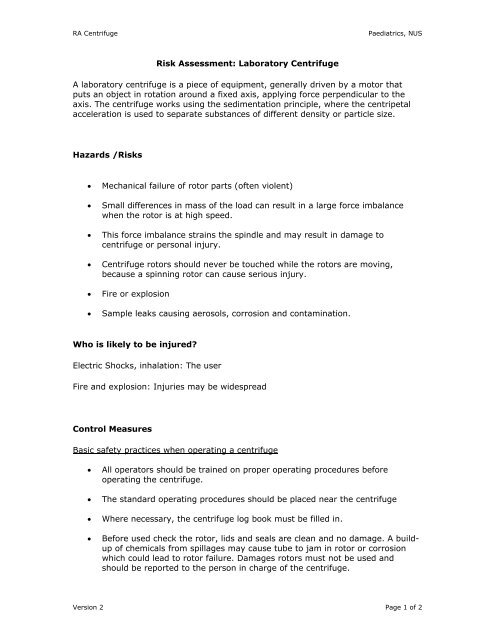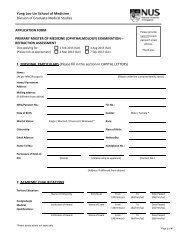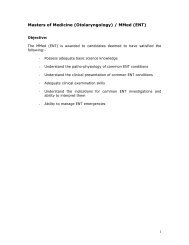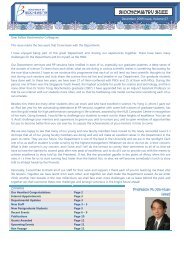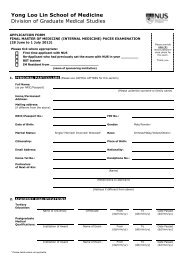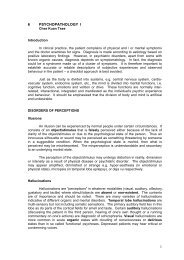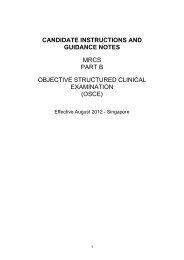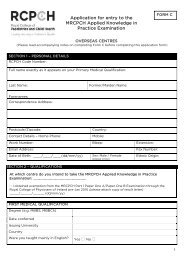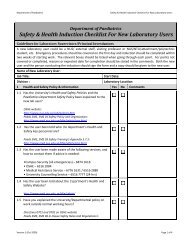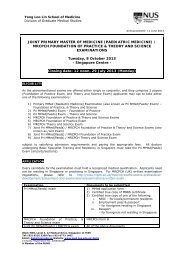Risk Assessment: Laboratory Centrifuge A laboratory centrifuge is a ...
Risk Assessment: Laboratory Centrifuge A laboratory centrifuge is a ...
Risk Assessment: Laboratory Centrifuge A laboratory centrifuge is a ...
You also want an ePaper? Increase the reach of your titles
YUMPU automatically turns print PDFs into web optimized ePapers that Google loves.
RA <strong>Centrifuge</strong> Paediatrics, NUS<br />
<strong>R<strong>is</strong>k</strong> <strong>Assessment</strong>: <strong>Laboratory</strong> <strong>Centrifuge</strong><br />
A <strong>laboratory</strong> <strong>centrifuge</strong> <strong>is</strong> a piece of equipment, generally driven by a motor that<br />
puts an object in rotation around a fixed ax<strong>is</strong>, applying force perpendicular to the<br />
ax<strong>is</strong>. The <strong>centrifuge</strong> works using the sedimentation principle, where the centripetal<br />
acceleration <strong>is</strong> used to separate substances of different density or particle size.<br />
Hazards /<strong>R<strong>is</strong>k</strong>s<br />
• Mechanical failure of rotor parts (often violent)<br />
• Small differences in mass of the load can result in a large force imbalance<br />
when the rotor <strong>is</strong> at high speed.<br />
• Th<strong>is</strong> force imbalance strains the spindle and may result in damage to<br />
<strong>centrifuge</strong> or personal injury.<br />
• <strong>Centrifuge</strong> rotors should never be touched while the rotors are moving,<br />
because a spinning rotor can cause serious injury.<br />
• Fire or explosion<br />
• Sample leaks causing aerosols, corrosion and contamination.<br />
Who <strong>is</strong> likely to be injured?<br />
Electric Shocks, inhalation: The user<br />
Fire and explosion: Injuries may be widespread<br />
Control Measures<br />
Basic safety practices when operating a <strong>centrifuge</strong><br />
• All operators should be trained on proper operating procedures before<br />
operating the <strong>centrifuge</strong>.<br />
• The standard operating procedures should be placed near the <strong>centrifuge</strong><br />
• Where necessary, the <strong>centrifuge</strong> log book must be filled in.<br />
• Before used check the rotor, lids and seals are clean and no damage. A buildup<br />
of chemicals from spillages may cause tube to jam in rotor or corrosion<br />
which could lead to rotor failure. Damages rotors must not be used and<br />
should be reported to the person in charge of the <strong>centrifuge</strong>.<br />
Version 2 Page 1 of 2
RA <strong>Centrifuge</strong> Paediatrics, NUS<br />
• Check tubes and bottles for cracks and deformities before each use.<br />
• Never fill <strong>centrifuge</strong> tubes above the maximum recommended by<br />
manufacturer. (refer to instruction manual )<br />
• Never exceed the maximum stated speed for any rotor .<br />
• Always use sealed safety cups or sealed rotors with O-rings when working<br />
with infectious agents.<br />
• Wipe exterior of tubes or bottles with d<strong>is</strong>infectant prior to loading.<br />
• Open rotor in biological safety cabinets when working with infectious agents.<br />
• Stop the <strong>centrifuge</strong> immediately if an unusual condition (no<strong>is</strong>e or vibration)<br />
begins.<br />
• Decontaminate safety carriers or rotors and <strong>centrifuge</strong> interior after each use.<br />
• Wear proper protective equipment when operating a <strong>centrifuge</strong>.<br />
• To know location of eyewash stations and safety showers.<br />
General and Electrical safety<br />
• Users should operate the <strong>centrifuge</strong> according to instructions in the manual.<br />
• User must always ensure that power cable <strong>is</strong> in good condition, no wires<br />
exposed.<br />
Training<br />
• Users must be provided with proper training and instructions before<br />
attempting to use a <strong>centrifuge</strong>.<br />
<strong>R<strong>is</strong>k</strong> Remaining<br />
The level of r<strong>is</strong>k <strong>is</strong> low with proper training. However, constant vigilance <strong>is</strong> necessary<br />
to avoid injury and possibly serious burns.<br />
Date: 26 November 2009<br />
Prepared By: Dorothy Teo<br />
Approved By: A/Prof Daniel Goh<br />
Head of Department<br />
Paediatrics, NUS<br />
Version 2 Page 2 of 2


